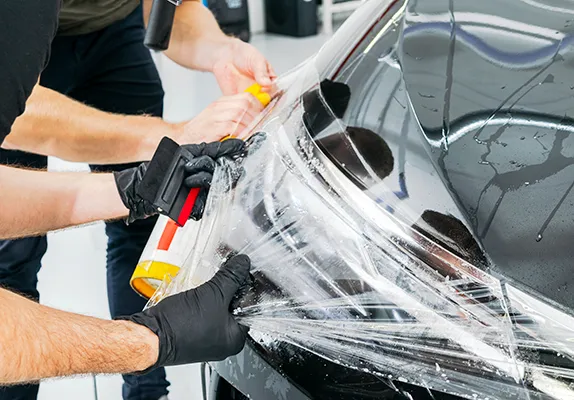
🚗 What is a Car Wrap Film?
Car wrap film is a multifunctional protective layer applied to a vehicle’s exterior surface. It serves both aesthetic and protective purposes and is a key product in the automotive aftermarket. Since its emergence in the 1960s, car wrap film has gone through stages of development—from its early days to rapid growth, and now to a mature market with ongoing innovation. With healthy competition between domestic and international brands, car film is expected to keep evolving toward higher-end, smarter, and more eco-friendly solutions.
TPU Car Wrap Film

🧩 What Types of Car Films Are There?
The market offers a wide range of car wrap films, which can be confusing to consumers. Here’s a breakdown based on core characteristics:
1. By Material
Every type of car film is made from base materials, each offering different advantages.
- PVC (Polyvinyl Chloride) Affordable and easy to apply, with basic waterproofing and scratch resistance. Ideal for DIY users, but lacks durability—best for short-term use.
- PET (Polyethylene Terephthalate) High transparency and good weather resistance. PET is recyclable and colorfast. However, it has weaker scratch resistance and limited UV/heat insulation. Not suitable for long-term or high-protection needs.
- TPU (Thermoplastic Polyurethane) Premium material with excellent stain resistance, flexibility, and self-healing ability. Great for covering complex curves and surfaces, making it ideal for both paint protection and color wraps. Though more expensive and difficult to apply, TPU is considered the most cost-effective high-end material.
- Dyed Film Made by adding dye to PET film. Provides color and basic heat insulation at a very low price. However, it fades easily and offers weak UV protection.
- Metalized Film Created by magnetron sputtering metal onto PET. Offers good UV blocking and stable color. Some downside: metals like aluminum, nickel, and copper can interfere with GPS and electronic signals. Also relatively expensive.
- Hybrid Dyed-Metal Film Combines dyed and metal layers for enhanced heat rejection, UV protection, and privacy. Cost-effective, but still prone to fading and potential signal interference due to the metal layer. Multi-layer structure also makes it harder to install.
- Ceramic Film Uses nano-ceramic particles on PET instead of metal. It avoids the signal interference problems of metalized films and offers excellent performance. However, it’s expensive. Unlike reflective films, ceramic film insulates by absorbing and filtering infrared rays, which may raise glass temperature under prolonged sunlight.

2. By Application Area (Function)
✅
Window Films
Applied to car glass (windshield, side windows, rear window, sunroof, mirrors). Functions include:
- UV protection
- Anti-shatter
- Privacy shielding
✅
Body Films
Body films are typically divided into two types:
- Paint Protection Film (PPF / Clear Bra) A transparent film applied to painted surfaces for protection. Can cover the whole car or vulnerable parts. Protects against scratches, rain, acid rain, UV rays, and minor abrasions. Often features self-healing capabilities.
- Color Wrap Film In addition to protection, color wraps provide personalized style and allow full-body color changes. A great way to refresh your vehicle’s look while safeguarding the paint underneath.


No results found
You can try clearing any filters or head to our store’s home
